Official Name:
Vaca Muerta (Spanish for "dead cow") refers to a dried-up riverbed near the meteorite's impact site. This is the meteorite's most common name, but it has a dozen secondary names drawn from other local topography.
Location:
Southeast of Taltal, in the Atacama Desert of Chile.
Fall or Find:
Find
Date:
The meteorite was discovered in 1861. The fall occurred much earlier, in prehistoric times.
Mass Recovered:
Over 3 782 kilograms of meteoritic matter have been recovered over the years. Vaca Muerta is the most massive stony-iron meteorite discovered to this day. Its preatmospheric mass has been estimated at over six metric tons.
Number of Fragments:
The Vaca Muerta meteorite fell as a shower. Over the years, hundreds of fragments have been collected. The mass of these fragments varies from a few grams to 309 kilograms.
Strewn field:
The official strewn field has been estimated to be 11.5 kilometres by 2.1 kilometres. However, fragments have been found 160 kilometres away from the official strewn field area. Perhaps the discoverers made a mistake in recording the location where they found the fragments. Or perhaps the meteorites were transported by human populations.
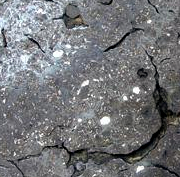
Enlargement
The Vaca Muerta meteorite is composed of a mixture of iron and silicates. Various inclusions and shock structures can easily be seen on this cut. |
|
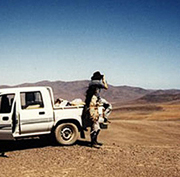
Enlargement
Meteorite hunter Geoff Notkin during an expedition in the Atacama Desert. |
|
Crater:
One impact structure has been discovered. This crater is 10.5 metres in diameter and 1.7 metres deep. Small meteorites were scattered around the crater.
Circumstances:
Vaca Muerta's strewn field was located in 1861. The vast majority of the fragments had never been moved. A few fragments were broken, probably by prospectors looking for precious metals. These explorers left their mark: their tools lie near the broken meteorites.
History:
From the time it was discovered until the beginning of the 20th century, geologists and mining entrepreneurs from many countries scoured the strewn field. The search was facilitated by the dark colour of the meteorites, which contrasts with the desert's golden sand.
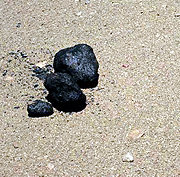
Enlargement
Three fragments of Vaca Muerta near a blown-glass bottle. The presence of historic artifacts reveal past activity at the fall site. |
|
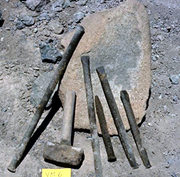
Enlargement
The scientists who mapped the strewn field discovered more than just meteorites. They found caches of tools. These instruments were used to break fragments and extract the metal from them. |
|
Type:
Stony-iron meteorite
Class:
Mesosiderite
Composition:
Vaca Muerta belongs to the rare stony-iron meteorite family. Its principal constituents are olivine and magnetite. Vaca Muerta contains numerous silicate inclusions and eucrite nodules. These inclusions represent 10% of the meteorite's volume, which makes it different from other mesosiderites.
What is the reason for this heterogeneous composition? Vaca Muerta's parent body probably had countless collisions with bodies that had various compositions. With each impact, a little material broke, mixed, and crystallized in the asteroid that would eventually cross paths with the Earth.
Scientific contribution:
According to isotopic analysis, this meteorite was last exposed to cosmic rays about 3 500 years ago. This means it landed on Earth about 3 500 years ago.
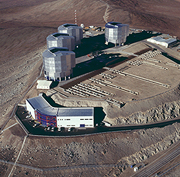
Enlargement
The VLT on Cerro Paranal (Chile) has four main telescopes with 8.2-metre diameters. |
|
Comments:
Fragments of the meteorite are still found in the fall zone from time to time today. But astronomy enthusiasts in the Atacama Desert have more to do these days than just stare at the ground-now they also have the Very Large Telescope (VLT), located at the Paranal Observatory.
Part of the Planétarium's collection:
Yes